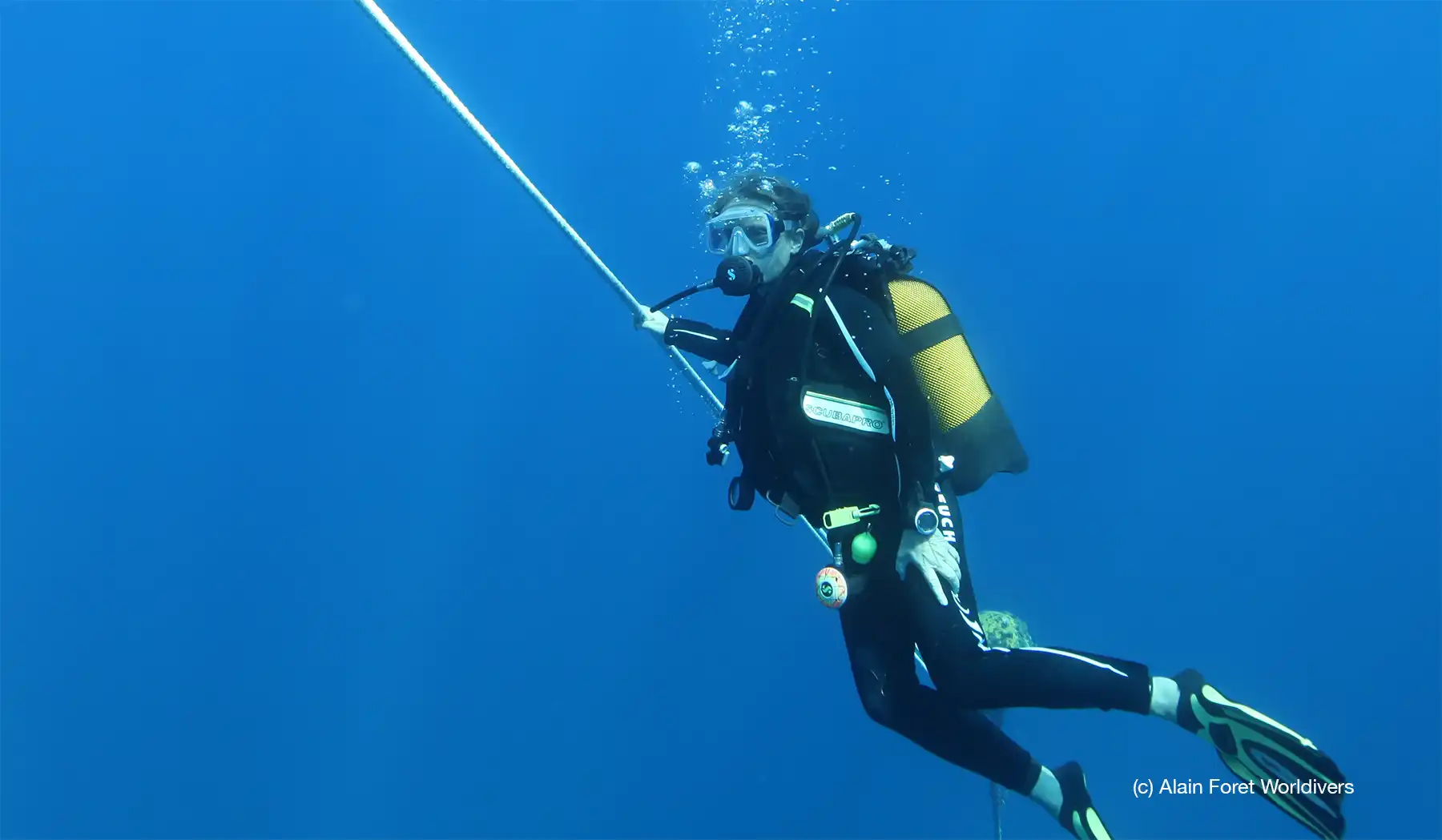Deep Stops
Ref. 25-025/CMAS/TC - 15 August 2025

Definition
Deep stops include :
- Stops at half the maximum depth (also known as "Pyle stops");
- Stops deeper than those proposed by the desaturation model [1], due to the setting of gradient factors (GF), in particular with a GFlow lower than GFhigh (see factsheet about GF).
Origin of deep stops (Pyle stops)
The origin of the so-called ‘deep stops’ is attributed to Richard Pyle [2], a marine biologist who, in the mid-1990s, was collecting fish at great depths while diving with mixtures (helium) off Hawaii.
Questioning his state of fatigue, which varied according to the dive, he realised that he was extremely tired at the end of dives without having found any fish and that he felt in much better shape each time he had been able to catch fish.
Comparing his dive profiles, he found that when he ascended with fish, he regularly stopped for one or two minutes during the ascent so that the fish could release some of the gas contained in their swim bladders, which was essential for their survival.
Richard Pyle arbitrarily adopted the following procedure:
Questioning his state of fatigue, which varied according to the dive, he realised that he was extremely tired at the end of dives without having found any fish and that he felt in much better shape each time he had been able to catch fish.
Comparing his dive profiles, he found that when he ascended with fish, he regularly stopped for one or two minutes during the ascent so that the fish could release some of the gas contained in their swim bladders, which was essential for their survival.
Richard Pyle arbitrarily adopted the following procedure:
- Normal calculation of his desaturation and determination of the depth of the first stop.
- Stop for one or two minutes halfway between the bottom and the first stop proposed by the desaturation protocol.
- Recalculation of the desaturation by integrating the time of the deep stop into the dive time and so on until the 10 m zone is reached.
- The practice of ‘deep stops’ has its origins in helium diving (trimix, heliox).
- The aim is to eliminate as many bubbles as possible at depth before continuing to ascend, in order to prevent the risk of desaturation accidents.
Extension to deeper stops than those normally calculated
At the Decompression And The Deep Stop workshop in 2008, a Consensus Session led by Dr Simon Mitchell [1] indicated that, in addition to strictly half-depth stops, all stops deeper than those proposed by the initial parameter sets of a desaturation model (for example using GF 30/70 or 50/80 with ZH-L 16 C) could be considered ‘deep stops’.
A fad effect
This was all it took for a “fad” to take hold and for dive computers to extrapolate the “deep stops” of helium dives to air dives.
However, from a strictly scientific point of view, nothing had been validated.
In other words, the software programmed into diving computers incorporated “deep stops” for air dives even though the mathematical models had not taken them into account. Reminder: dive computer software is not certified (see factsheet).
However, from a strictly scientific point of view, nothing had been validated.
In other words, the software programmed into diving computers incorporated “deep stops” for air dives even though the mathematical models had not taken them into account. Reminder: dive computer software is not certified (see factsheet).
Deep stops: dangerous with air
Since 2005, various studies have confirmed the danger of deep stops for air dives, with an increase in the level of bubbles rather than a reduction, even for shallow dives:
Information: For nitrogen dives (air, nitrox), the peak of bubbles appears 30 to 60 minutes after exiting the dive.
- Blatteau J.-E., Hugon M., Gardette B., Galland F.-M., Protocoles de décompression pour la plongée à l'air intégrant des paliers profonds, Bulletin de médecine subaquatique et hyperbare, 2005, pp 85-91.
- Doolette D.J. ; Gerth W.A. ; Gault K.A., Redistribution of decompression stop time from shallow to deep stops increases incidence of decompression sickness in air decompression dives, Navy Experimental Diving Unit (NEDU), 2011.
- Nico A.M. Schellart, Jan-Jaap Brandt Corstius, Peter Germonpré, and Wouter Sterk, Bubble Formation After a 20-m Dive: Deep-Stop vs. Shallow-Stop Decompression Profiles, Aviation, Space, and Environmental Medicine x Vol. 79, No. 5 x May 2008.
Information: For nitrogen dives (air, nitrox), the peak of bubbles appears 30 to 60 minutes after exiting the dive.
Deep stops: recommended for helium
For helium dives (heliox, trimix), bubbles start to appear much lower down than for nitrogen dives (air, nitrox).
In this context, work by Comex [3] has shown the need for deep stops (half the depth or more) of short duration (1 min) to reduce the risk of bends, inner ear ADD and osteonecrosis. Hence the need, for this type of diving, to use reversed GFs to force deep stops. (see factsheet about GF).
In this context, work by Comex [3] has shown the need for deep stops (half the depth or more) of short duration (1 min) to reduce the risk of bends, inner ear ADD and osteonecrosis. Hence the need, for this type of diving, to use reversed GFs to force deep stops. (see factsheet about GF).
To sum up
Deep stops" are :
- Not recommended for nitrogen dives (air, nitrox);
- Recommended for helium dives (heliox, trimix).
[1] Workshop – Decompression And The Deep Stop, Salt Palace Convention Center, Salt Lake City, Utah, US, June 24-25, 2008 - Consensus Session, Dr Simon Mitchell, p. 305.
[2] Richard Pyle, The importance of deep safety stops: rethinking ascent patterns from decompression dives, SPUMS Journal Vol 27 No.2 June 1997.
[3] Gardette B., Plutarque M., Comex, 50 ans de recherches et d'expérimentations, Cacx, 2012.
[4] Blatteau J.-E., Hugon M., Gardette B., Galland F.-M., Protocoles de décompression pour la plongée à l’air intégrant des paliers profonds, Bulletin de médecine subaquatique et hyperbare, 2005, pp 85-91.
[5] Doolette D.J. ; Gerth W.A. ; Gault K.A., Redistribution of decompression stop time from shallow to deep stops increases incidence of decompression sickness in air decompression dives, Navy Experimental Diving Unit (NEDU), 2011.
[6] Nico A.M. Schellart, Jan-Jaap Brandt Corstius, Peter Germonpré, and Wouter Sterk, Bubble Formation After a 20-m Dive: Deep-Stop vs. Shallow-Stop Decompression Profiles, Aviation, Space, and Environmental Medicine x Vol. 79, No. 5 x May 2008.









